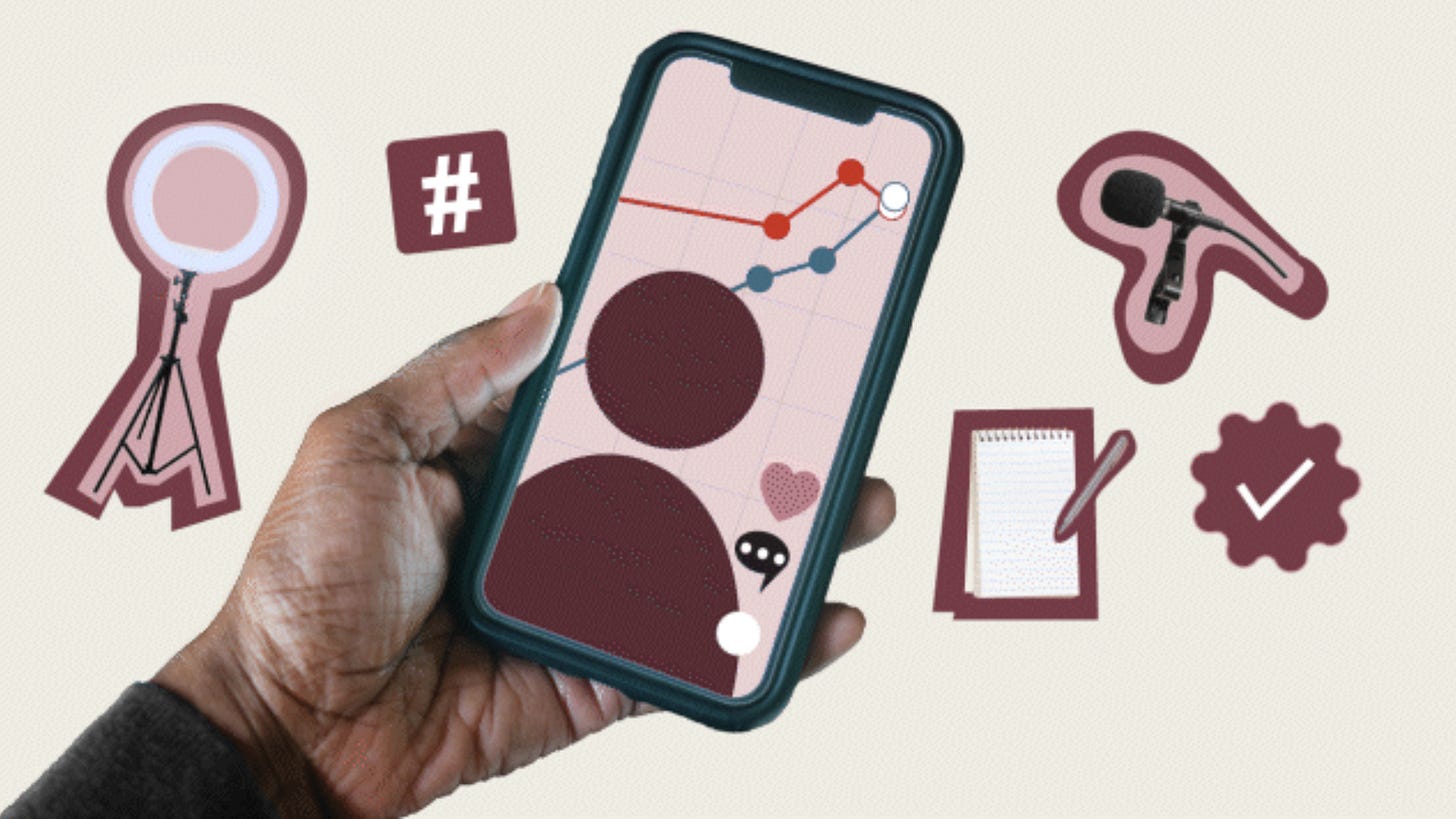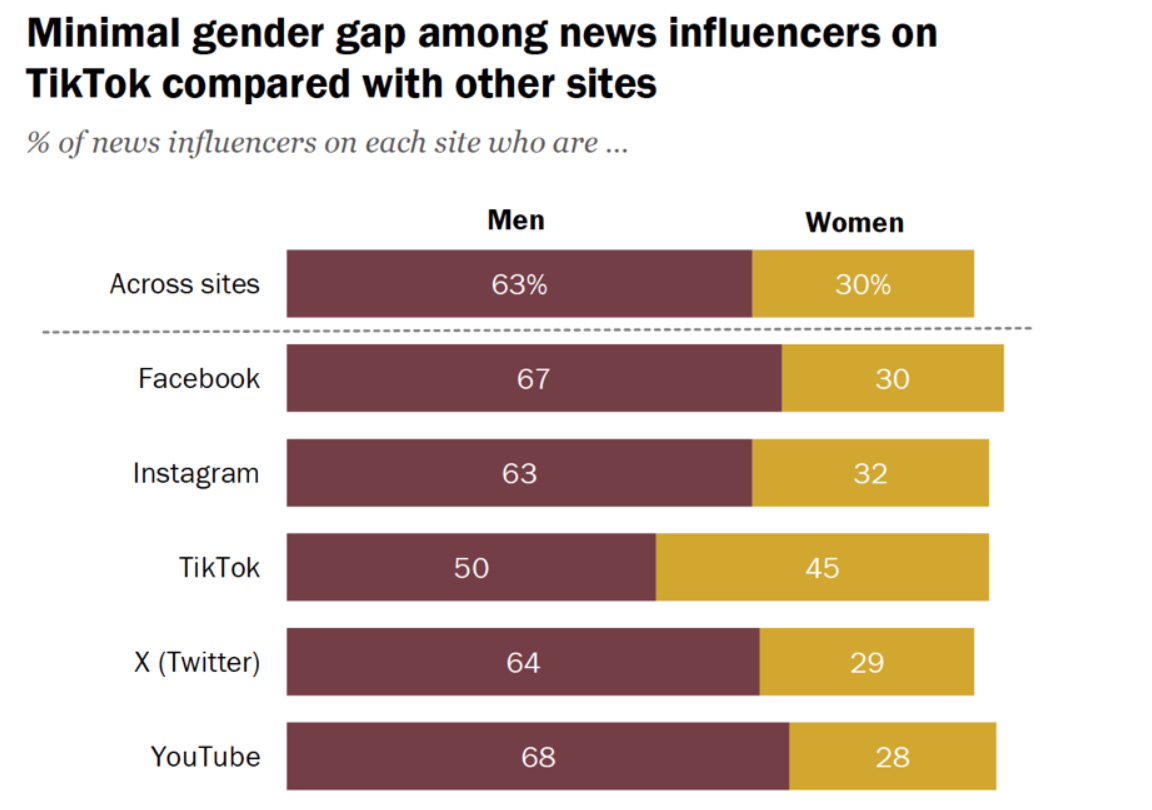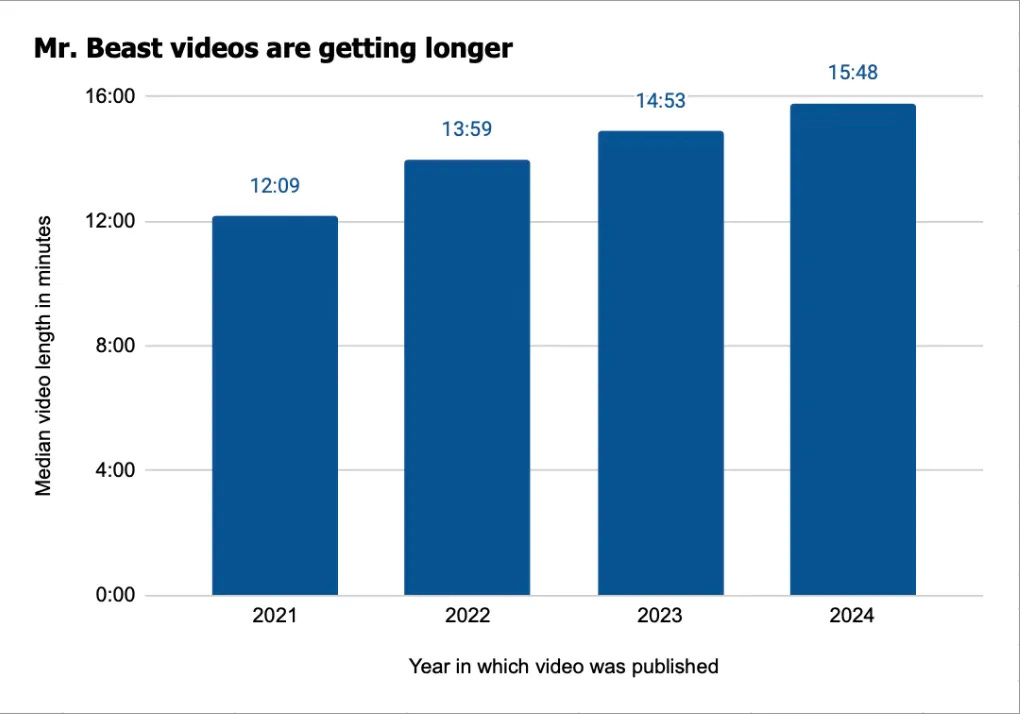Keep scrolling for the latest way TikTok users are consuming brainrot.
The majority of news influencers are men
Whether it is news about the creator economy or politics, Gen Z are choosing to get their news online. While this is nothing new, little attention has been paid to who is delivering these stories and their biases. According to data by the Pew Research Center, online news influencers are predominantly men and more likely to be conservative.
The analysts reviewed a sample of 500 popular news influencers and examined the content they produced after reviewing over 28,000 different social media accounts.
Through this examination, the Center found that one in five Americans – with 37% of adults under 30 – regularly get news from influencers on social media.
“Among Americans who get news from news influencers on social media, most (65%) say news influencers have helped them better understand current events and civic issues,“ the report reads.
These news influencers don’t fully reflect the political or gender diversity of their audiences. The majority (62%) are men, with a slightly larger share identifying as Republican, conservative, or pro-Donald Trump (27%) than as Democratic, liberal, or pro-Kamala Harris (21%).
Interestingly, TikTok stands out with a smaller gender gap and more balanced political representation. It’s also the only platform where left-leaning creators outnumber their right-wing counterparts (28% vs. 25%).
Pew doesn't go into detail about why men and conservative views are over-represented among news influencers, but Taylor Lorenz discusses a number of factors in User Mag.
“Social media platforms have long boosted men's voices over women’s. The refusal to tamp down on misogynistic hate and harassment, or provide users with tools to protect themselves, has resulted in the silencing of women's voices across the internet,” she explains. “This dynamic is especially pronounced on platforms like YouTube and Twitter.”
Read the report via Pew Research Center.
How fans saved Sexypedia from being erased from the internet
Now, for some niche internet news, Adam Bumas for WIRED breaks down everything going down with Sexypedia.
For those unfamiliar with Sexypedia, it is essentially a fan-run wiki chronicling the phenomenon of the “Tumblr Sexyman.”
“The term [Tumblr Sexyman] arose in the early 2010s, after Tumblr’s users noticed commonalities between the most popular characters on the site,“ Bumas explains. “The term has shifted to describe a range of fan favorites. More than a specific label, ‘Tumblr Sexyman’ is a way to think about discrete fan communities as linked, part of a greater cultural movement.”
The Sexypedia wiki was created in 2020 (mainly as a joke) but would soon become the “primary reference text” for this movement.
However, at the end of last month, fans of Sexypedia found years of archived work erased. Fandom, the for-profit company hosting the site, had abruptly closed the site.
The shutdown supposedly followed a YouTube video created by Trig Jegman, a volunteer for various other Fandom wikis, who alleged various policy violations. Meanwhile, moderators and fans claim that the site adhered to PG-13 standards despite accusations of explicit content.
Fandom denied Sexypedia’s appeal, so the team moved the project to Miraheze, a non-profit hosting platform.
“The community lent their full support to the decision, and for the next two weeks the Discord was a hive of activity, preparing the legions of skinny white men before the new site was approved on November 11. It’s currently under construction, but it appears as though the one-of-a-kind catalog of fan love has been saved,” Bumas concludes.
The downfall of Sexypedia, combined with last month’s hack of the Internet Archive, has reignited conversations about the internet’s fragility. Despite its reputation for permanence, the digital world may be far more ephemeral than it seems.
Read the full story via WIRED.
While Sexypedia might have made it out alive (this time), the mid-length video is seemingly dying a slow, painful death. A recent edition of The Etymology Nerd Substack explores how the most popular videos online seem to either be long-form or short-form content.
According to The Etymology Nerd’s (aka Adam Aleksic) analysis, video lengths are creeping up. But this isn’t because creators and platforms are hoping to entertain audiences. Instead, it is all about retention and maximising revenue.
“Entertainment is just a byproduct of that objective, which explains why there’s so much shitty clickbait and ragebait on the platforms: the content holds your attention, even if it’s not what actually entertains you the most,” the article reads.
Studies show the average viewer prefers videos around 7–10 minutes, but YouTube’s algorithm favours longer content. Pointing to 2018 Pew Research Data, The Etymology Nerd notes that YouTube recommendations get progressively longer as the viewer engages with content.
“Creators, in turn, are pressured to make ever-longer YouTube videos. Long-form content is not only more profitable for us, but also more likely to go viral because of how the algorithm works—so we respond by changing the format of our storytelling,” Aleksic explains.
Analysing popular creators like MrBeast proves the point. As The Etymology Nerd notes, the median length of MrBeast's videos has increased every year since 2021.
“This isn’t an accident. Mr. Beast is very knowledgeable about changes to the algorithm, and is very intentional about responding to them,” Aleksic continues. “All creators are trending in the same direction as they figure out what works, meaning that we’re collectively moving toward a future dominated by extended video essays instead of the ten-minute content viewers most want to see.”
Read the analysis via The Etymology Nerd Substack.
The real reward of all these celebrity look-alike contests
Social media users may not prefer to watch longer-form content, but they’ll happily tune into hours-long look-alike competitions on live stream. In a new piece for Vogue, Raven Smith discusses the growing popularity of look-alike contests and why the internet is obsessed with these events.
Look-alike competitions have taken over and it all started with a Timothée Chalamet look-alike event in Washington Square Park.
The trend has since spread globally, with competitions for Harry Styles, Paul Mescal, Zayn Malik, and others, where fans dressed like their favourite celebrities compete for prizes, sometimes with unexpected results (like Timothée Chalamet actually showing up).
Smith argues that our obsession with these events reflects a broader cultural tendency to gravitate towards familiar content, preferring remakes (whether it is a film like Wicked or a lookalike contest) over new stories and experiences.
“The look-alike thing feels like an inoffensive trend—a local frenzy that harms nobody, a deluge of unseriousness. But I can’t help thinking that, culturally, everything is a remake,” she writes. “We’re inundated with remakes—recognizable storylines and premises that repeat the familiar rather than juddering-ly rearrange our worldview.”
It's not entirely surprising that this is becoming popular now — especially after the US election and other traumatic global events that leave many young people unsure about what comes next.
“The global stage is chockablock with harrowing new news and curveball political surprises; every day we scroll through a million real-life jump scares,” Smith continues. “When searching for reprieve, there’s sanctuary in a movie musical that looks like a Broadway smash, [or a] Harry Styles simile. We already know the winners and losers; the outcome can’t be enough of a shock to keep us awake all night.”
Read the piece via Vogue.
‘PDF to Brainrot’ study tools are a strange iteration on a TikTok trend
If you thought the look-alike competitions were unserious, I raise you: PDF to Brainrot. Journalist Amanda Silberling explores the phenomenon in a new piece for Tech Crunch.
This trend essentially blends homework with brainrot, where many students use various tools to convert PDFs into formats they find easier to engage with.
Platforms like Coconote, Study Fetch, and StudyRot are some of the most popular, letting students convert dense study material into an audio-visual experience.
“[The AI-Based study tool will] read the text of a document you upload over ‘oddly satisfying’ videos, like ASMR clips of mixing paint and cutting soap, or gameplay footage from Minecraft and Subway Surfers,” she explains. “Then students can listen to an automated voice read their textbooks to them while they watch these vertical videos, which people on TikTok often refer to as ‘brainrot’ material.”
 @ibgradi hate that it’s genuinely good 😭😭 #studytips #studytok #internationalbaccalaureate #edutok #studentlife #aitoolsforstudents #studyadvice #universitystudent #lawstudent #academicweapon #pdftobrainrot #uni Do you guys know those videos of the reddit stories being read out with a subway surfers gameplay in the background? Theres now a whole study website that lets you upload your notes or powerpoints slides or lecture transcripts, etc. and it turns it into a brainrot version 😭 its free as well
@ibgradi hate that it’s genuinely good 😭😭 #studytips #studytok #internationalbaccalaureate #edutok #studentlife #aitoolsforstudents #studyadvice #universitystudent #lawstudent #academicweapon #pdftobrainrot #uni Do you guys know those videos of the reddit stories being read out with a subway surfers gameplay in the background? Theres now a whole study website that lets you upload your notes or powerpoints slides or lecture transcripts, etc. and it turns it into a brainrot version 😭 its free as wellTiktok failed to load.
Enable 3rd party cookies or use another browserSome of these study tools, specifically StudyRot, add a layer of Gen Z flavour by translating academic texts into the latest internet slang. And while this may be helpful to engage students, there are some obvious problems.
“Giving the AI too much liberty to manipulate the source text is probably not a great study strategy, since you might end up with inaccurate summations; did Odysseus really have rizz, or was he a sigma male?” Silberling ponders.
Read the story via Tech Crunch.











